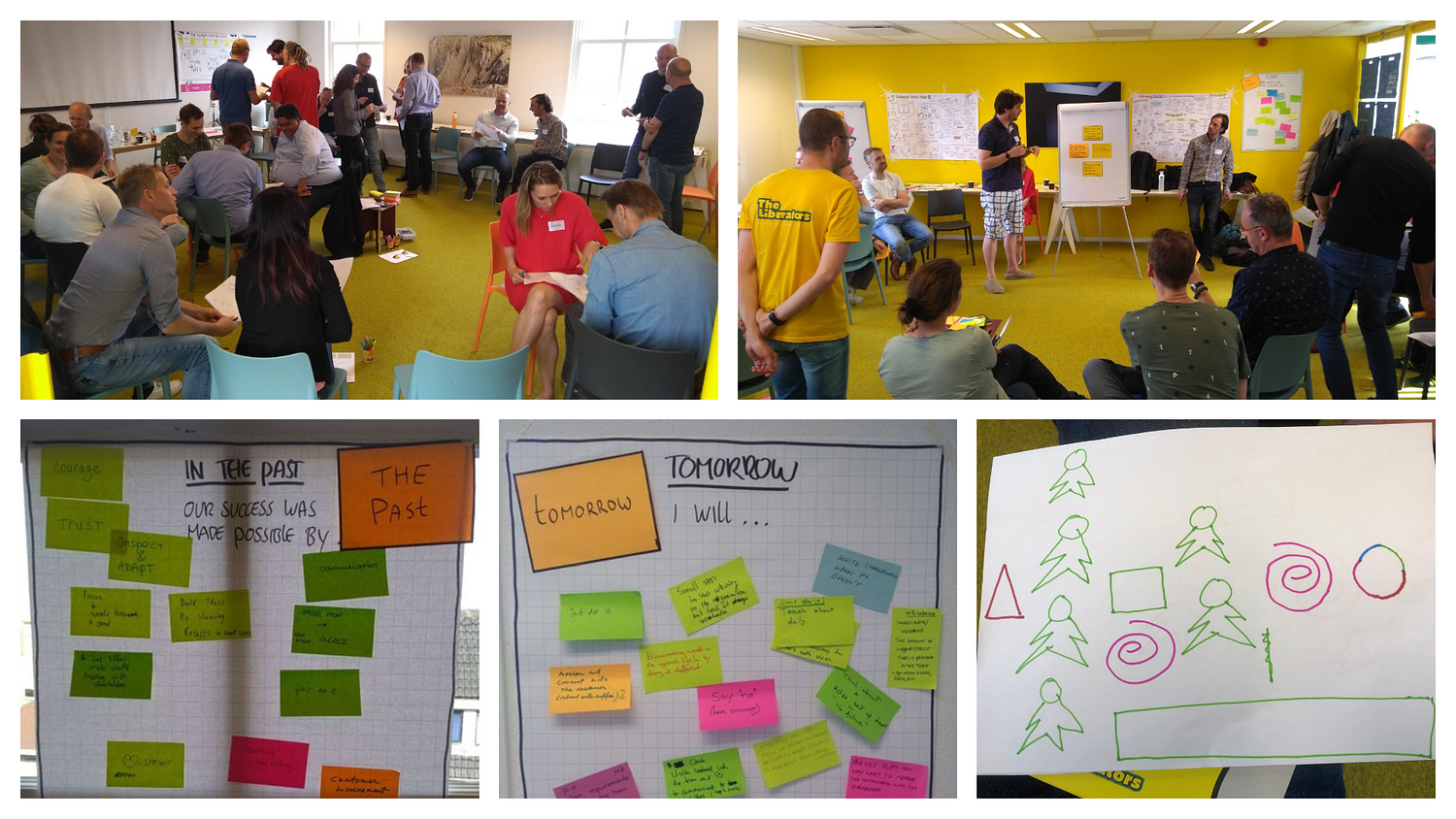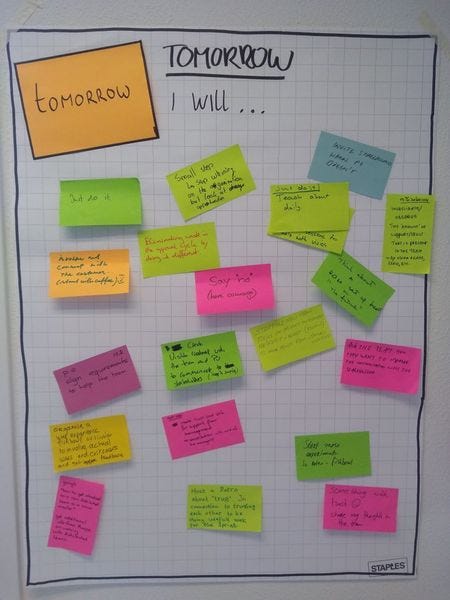During a recent meetup of The Liberators Network, we got together with 30 enthusiastic Scrum Masters. Together, we explored what made our success possible. We used a string of Liberating Structures to explore three aspects; what has your professional journey looked like up to this point (Drawing Together)? What made your past successes possible (Appreciative Interviews)? What are the steps you can make now to invest in those factors today (15% Solutions)? And what will make your future success possible (Future~Present)?
In this post, we share the results from the conversations that ensued. This post combines the shared experience of a large group of Scrum Masters.

An impression of the meetup and some of the results we generated (bottom-left is Appreciative Interviews, bottom-middle is 15% Solutions and bottom-right is Drawing Together)
1. One step at a time
A recurring theme in most stories was to take one step at a time and celebrate successes that result from those steps. Setting up a deployment pipeline doesn’t have to be perfect overnight; it is enough if one small-but-tedious step can be automated. Trying to shift the entire organisation to adopt a more agile mindset towards projects is daunting, but finding at least one Product Owner who sees the value in working incrementally is already a win. Getting a single unit test to work will make all the others easier. Simplifying the purchasing process for Scrum Teams so they can purchase training and materials up to threshold without going through several departments is a huge win.
Much like building our products incrementally with Scrum, and seeing it take shape over many Sprints, so does the understanding and implementation of the empirical process of Scrum. One participant summarized this as “Just do it”; stop talking and start doing.
2. “Done” is the driver
Participants agreed that “Done” software is the driver of change; software that is released to production and in the hands of users. Anything less risks keeping assumptions alive about what is needed, how difficult or how valuable it will be. By keeping the focus of Sprints on delivering software that is done to this extent, all issues, blockades, and impediments that are getting in the way become very visible. By solving one of those impediments each Sprint, incremental change is made possible.
The participants also agreed that by delivering done software every Sprint, stakeholders start trusting the experience-driven approach of Scrum. As they notice that new and valuable ideas are picked up and delivered in consecutive Sprints, the focus shifts from guarantees and deadlines to flexible budgets and in-the-moment improvements.
3. Involve stakeholders
Actively involving stakeholders, and encouraging Scrum Teams to do so, turned out to be a strong enabler of success. When stakeholders are not involved, not only can you no longer build a good product, you will also not be able to demonstrate that Scrum works. In most of the success stories, the involvement was not limited to the Sprint Review. Often, Development Teams also refined items with stakeholders, invited them to join Sprint Planning or visited them at their workplaces to better understand what they needed.
Several participants noted that there is often a huge gap between understanding this and actually doing it. There is an understandable hesitation to invite stakeholders to inspect what may feel like “a product that isn’t done” or for stakeholders to offer feedback on the hard work done by the Development Team. Scrum Masters can address this by repeating, over and over, that Scrum is incremental; products are never completely done. And feedback is not annoying; it is vital to improving a product over time.
4. Experiment
Experiments are the best friends of Scrum Masters. They can involve new practices (like ‘Swarming’ for one participant), changing the length of Sprints to different team compositions. We all have our habits. Changing something without knowing what the result will look and feel like is bound to trigger understandable hesitation and resistance.
Experiments are by definition based on experience, making them fit well with Scrum. They emphasize that we don’t know the solution yet, and we have to try a potential option to know whether or not it helps us move forward. By making active experiments transparent (e.g. with Lean Change Management) and by defining together when an experiment is successful, teams can make change feel less scary or abrupt. Some experiments will turn out to be successful, and lead to incremental change, whereas others will fail or not show improvement.
5. Find support
A final enabler that occurred in many stories was finding support. For some, this meant finding help in other Scrum Masters, team members, and inspiring mentors. For others, it was finding support in (senior) management to drive change and break down barriers. Either way, changing even the complex system of a single team is not something you can usually do on your own. Having access to the wisdom, experience, and creativity of others make it easier to find novel solutions for persistent problems.

Next steps for attending Scrum Masters. What can you do to invest in the factors we identified together
Concluding thoughts
It is interesting to note what wasn’t mentioned. There was no mention of specific skills, practices, training or certificates. It is also interesting to note that there was a lot of overlap. This shows that we know quite well what makes our success as Scrum Masters possible. It's not a black box; We have to start small, taking one step at a time and demonstrating results to the people we’re doing it for in order to build trust and gather feedback. We have to find help in others, both to spur our creativity to deal with the complex problems we’ll face and to break through impediments.
How are you investing in those enablers? How are you as a Scrum Master, or as part of a Scrum Team?

